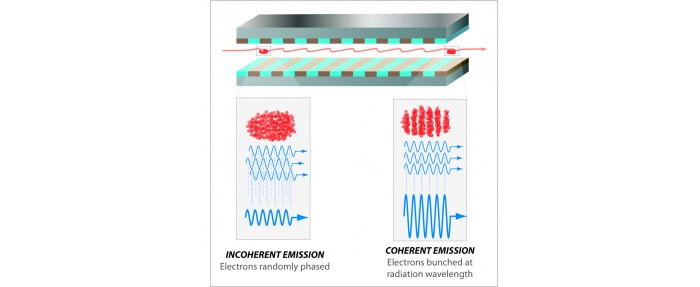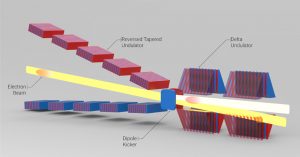The aim of the FLS Group’s research is to develop new methods in the generation of high brightness X-ray photon pulses that would allow the spatiotemporal imaging of events at the atomic scale (~1 Å, ~10 as (atto-second)). The spatial and temporal resolution available from such x-ray pulses would make feasible the observation and ultimately the potential to control ultra-fast, optionally non-linear, atomic processes. With the ability to probe correlated electronic processes within atoms at these timescales, to measure how electrons and nuclei reorganise themselves, either individually within atoms due to external stimulus, during molecular bond making and breaking, or while undergoing subtle catalytic or biological processes, we can begin to unravel how all matter functions at this fundamental level.

FEL operating principle. When electrons enter the undulator,their initially random phases ensure that mostly incoherent radiation is emitted at the resonant radiation wavelength (left). Because the electrons interact collectively with the radiation they emit, small coherent fluctuations in the radiation field grow and simultaneously begin to bunch the electrons at the resonant wavelength. This collective process continues until the electrons are strongly bunched towards the end of the undulator, where the process saturates and the electrons begin to de-bunch.
A UK XFEL facility would provide such novel output and address future science and technology questions aligned with government Industrial Strategy and Grand Challenges. There will also be new challenges and strategies that emerge. Advanced XFEL designs offer cutting-edge tools for imaging matter at the natural spatial and temporal scales for many important processes: such capability will remain a core requirement for all scientific and technological research that depends on an understanding of how matter works at the nanoscopic and quantum level, and will enable the development of new technologies based upon that understanding.A UK XFEL would be a major facility costing of the order of £1 billion, providing users with light into the 2050’s. It would be part of a network of international facilities, each generating unique types of light unavailable elsewhere. A UK XFEL will therefore be a cutting-edge machine from first light.
Examples of some of our recent work include:
A Free Electron Laser set up for the generation of ‘structured light’

Free electron laser generation of x-ray Poincaré beams, Morgan, J., Hemsing, E., McNeil, B. and Yao, A.M., New J. Phys. 22, 093009 (2020)
First simulations of structured light output from an FEL

Free electron laser generation of x-ray Poincaré beams, Morgan, J., Hemsing, E., McNeil, B. and Yao, A.M., New J. Phys. 22, 093009 (2020)
Simulations of sub-attosecond pulse output in an X-ray FEL

Attosecond single-cycle undulator light: a review, Mak, A., Shamuilov, G., Salén, P., Dunning, D., Hebling, J., Kida, Y., Kinjo, R., McNeil, B.W., Tanaka, T., Thompson, N. and Tibai, Z, Reports on Progress in Physics 82, no. 2 (2019): 025901